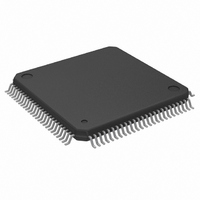M306N5FCTFP Renesas Electronics America, M306N5FCTFP Datasheet - Page 117

M306N5FCTFP
Manufacturer Part Number
M306N5FCTFP
Description
IC M16C MCU FLASH 100QFP
Manufacturer
Renesas Electronics America
Series
M16C™ M16C/6Nr
Datasheets
1.M30622SAFPU5.pdf
(308 pages)
2.M306N5FCTFPUK.pdf
(90 pages)
3.M306N5FCTFPU0.pdf
(408 pages)
Specifications of M306N5FCTFP
Core Processor
M16C/60
Core Size
16-Bit
Speed
20MHz
Connectivity
CAN, I²C, IEBus, SIO, UART/USART
Peripherals
DMA, WDT
Number Of I /o
87
Program Memory Size
128KB (128K x 8)
Program Memory Type
FLASH
Ram Size
5K x 8
Voltage - Supply (vcc/vdd)
4.2 V ~ 5.5 V
Data Converters
A/D 26x10b; D/A 2x8b
Oscillator Type
Internal
Operating Temperature
-40°C ~ 85°C
Package / Case
100-QFP
Lead Free Status / RoHS Status
Contains lead / RoHS non-compliant
Eeprom Size
-
Available stocks
Company
Part Number
Manufacturer
Quantity
Price
Company:
Part Number:
M306N5FCTFP
Manufacturer:
ON
Quantity:
36 000
Company:
Part Number:
M306N5FCTFP#U0
Manufacturer:
Renesas Electronics America
Quantity:
10 000
Company:
Part Number:
M306N5FCTFP#UK
Manufacturer:
XILINX
Quantity:
1 400
Company:
Part Number:
M306N5FCTFP#UK
Manufacturer:
Renesas Electronics America
Quantity:
135
Company:
Part Number:
M306N5FCTFP#UK
Manufacturer:
Renesas Electronics America
Quantity:
10 000
Company:
Part Number:
M306N5FCTFP#UKJ
Manufacturer:
Renesas Electronics America
Quantity:
10 000
- Current page: 117 of 408
- Download datasheet (3Mb)
M16C/6N Group (M16C/6N5)
Rev.2.40
REJ09B0011-0240
12.1 Transfer Cycle
The transfer cycle consists of a memory or SFR read (source read) bus cycle and a write (destination write)
bus cycle. The number of read and write bus cycles is affected by the source and destination addresses of
transfer. During memory expansion and microprocessor modes, it is also affected by the BYTE pin level.
Furthermore, the bus cycle itself is extended by a software wait or RDY signal.
12.1.1 Effect of Source and Destination Addresses
12.1.2 Effect of BYTE Pin Level
12.1.3 Effect of Software Wait
12.1.4 Effect of RDY Signal
Figure 12.5 shows the Transfer Cycles for Source Read. For convenience, the destination write cycle is
shown as one cycle and the source read cycles for the different conditions are shown. In reality, the
destination write cycle is subject to the same conditions as the source read cycle, with the transfer cycle
changing accordingly. When calculating transfer cycles, take into consideration each condition for the
source read and the destination write cycle, respectively. For example, when data is transferred in 16-bit
unit using an 8-bit bus ((2) on Figure 12.5), two source read bus cycles and two destination write bus cycles
are required.
If the transfer unit and data bus both are 16 bits and the source address of transfer begins with an odd
address, the source read cycle consists of one more bus cycle than when the source address of transfer
begins with an even address.
Similarly, if the transfer unit and data bus both are 16 bits and the destination address of transfer begins
with an odd address, the destination write cycle consists of one more bus cycle than when the destination
address of transfer begins with an even address.
During memory expansion and microprocessor modes, if 16 bits of data are to be transferred on an 8-bit
data bus (input on the BYTE pin = high), the operation is accomplished by transferring 8 bits of data twice.
Therefore, this operation requires two bus cycles to read data and two bus cycles to write data.
Furthermore, if the DMAC is to access the internal area (internal ROM, internal RAM, or SFR), unlike in
the case of the CPU, the DMAC does it through the data bus width selected by the BYTE pin.
For memory or SFR accesses in which one or more software wait states are inserted, the number of bus
cycles required for that access increases by an amount equal to software wait states.
During memory expansion and microprocessor modes, DMA transfers to and from an external area are
affected by the RDY signal. Refer to 7.2.6 RDY Signal.
Apr 14, 2006
________
page 95 of 372
________
________
________
12. DMAC
Related parts for M306N5FCTFP
Image
Part Number
Description
Manufacturer
Datasheet
Request
R

Part Number:
Description:
KIT STARTER FOR M16C/29
Manufacturer:
Renesas Electronics America
Datasheet:

Part Number:
Description:
KIT STARTER FOR R8C/2D
Manufacturer:
Renesas Electronics America
Datasheet:

Part Number:
Description:
R0K33062P STARTER KIT
Manufacturer:
Renesas Electronics America
Datasheet:

Part Number:
Description:
KIT STARTER FOR R8C/23 E8A
Manufacturer:
Renesas Electronics America
Datasheet:

Part Number:
Description:
KIT STARTER FOR R8C/25
Manufacturer:
Renesas Electronics America
Datasheet:

Part Number:
Description:
KIT STARTER H8S2456 SHARPE DSPLY
Manufacturer:
Renesas Electronics America
Datasheet:

Part Number:
Description:
KIT STARTER FOR R8C38C
Manufacturer:
Renesas Electronics America
Datasheet:

Part Number:
Description:
KIT STARTER FOR R8C35C
Manufacturer:
Renesas Electronics America
Datasheet:

Part Number:
Description:
KIT STARTER FOR R8CL3AC+LCD APPS
Manufacturer:
Renesas Electronics America
Datasheet:

Part Number:
Description:
KIT STARTER FOR RX610
Manufacturer:
Renesas Electronics America
Datasheet:

Part Number:
Description:
KIT STARTER FOR R32C/118
Manufacturer:
Renesas Electronics America
Datasheet:

Part Number:
Description:
KIT DEV RSK-R8C/26-29
Manufacturer:
Renesas Electronics America
Datasheet:

Part Number:
Description:
KIT STARTER FOR SH7124
Manufacturer:
Renesas Electronics America
Datasheet:

Part Number:
Description:
KIT STARTER FOR H8SX/1622
Manufacturer:
Renesas Electronics America
Datasheet:

Part Number:
Description:
KIT DEV FOR SH7203
Manufacturer:
Renesas Electronics America
Datasheet:











